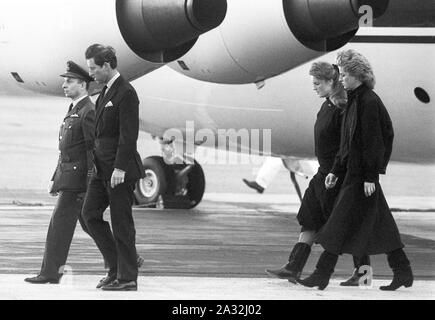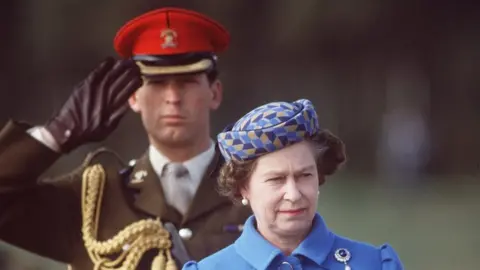In the intricate tapestry of royal history, certain events stand out not just for their public impact but for the profound personal stories woven within them. One such narrative revolves around Major Hugh Lindsay, a figure deeply connected to the British Royal Family, and his wife, Sarah Horsley. While his tragic death in an avalanche in 1988 sent shockwaves through the monarchy and the public, Sarah's subsequent journey of grief, resilience, and ultimately, remarriage, offers a poignant testament to the human spirit's capacity to heal and find new beginnings. This article delves into Sarah Horsley's story, exploring the devastating loss she endured, her quiet strength in the face of public scrutiny, and her decision to embrace a new chapter in her life.
Major Hugh Lindsay: A Royal Confidant and Friend
Major Hugh Lindsay was more than just an acquaintance to the Royal Family; he was a trusted friend and a respected figure within their inner circle. Educated at the prestigious Millfield School, Lindsay carved out a distinguished career that brought him into close proximity with the monarchy. He served as a former Queen's Equerry, a role that placed him in a position of considerable trust and responsibility, assisting the Queen in her daily duties and engagements. Beyond his official capacity, Major Hugh Lindsay fostered a particularly close friendship with Prince Charles, a bond that would make his sudden passing all the more devastating. His longstanding ties to the Royal Family meant his presence was a familiar and comforting one at various royal events and private gatherings.The Klosters Tragedy of 1988: A Turning Point
The winter of 1988 brought an unforeseen and devastating tragedy to the Royal Family and those close to them. While on a skiing holiday in Klosters, Switzerland, Major Hugh Lindsay was caught in a severe avalanche. Despite immediate rescue efforts, he was pronounced dead at the scene. The news sent shockwaves, particularly to Prince Charles, who was visibly distraught upon learning of his friend's death. The Los Angeles Times later reported that while Prince Charles could not be personally faulted for Lindsay's death, a report found that the entire group had collectively caused the avalanche and assumed a collective risk. The aftermath of the tragedy was deeply emotional and highly publicized. Princess Diana and Prince Charles were photographed standing near the wife of Major Hugh Lindsay on March 12, 1988, in London, England, following his death, a poignant image captured by Tim Graham Photo Library/Getty Images that conveyed the collective grief. Diana herself provided a detailed account of the harrowing aftermath, describing the return journey: "We arrived back at Northolt and we had Hugh’s coffin in the bottom of the aeroplane and Sarah was waiting at Northolt." This detail underscores the raw, personal nature of the loss and the immediate support offered by the royals to Sarah. Royal biographers have often cited the avalanche and the death of Major Hugh Lindsay as a significant turning point in Diana and Charles's already tumultuous marriage. The shared trauma and the differing ways they coped with it reportedly exacerbated existing tensions, marking a period of intense strain within their relationship.Sarah Horsley: Navigating Grief and Finding Support
For Sarah Horsley, the widow of Major Hugh Lindsay, the immediate aftermath of the Klosters tragedy was a period of immense personal grief compounded by public attention. Her presence at Northolt, awaiting her husband's coffin, was a moment of profound sorrow witnessed by those close to the royals. In the months and years following the tragedy, Sarah found an unexpected source of solace and support in Princess Diana. In a 2008 Telegraph interview, Sarah—who remarried in 1996—recalled Diana's unwavering support. This bond highlights Diana's compassionate nature and her ability to connect with individuals on a deeply personal level, offering comfort during their darkest hours. Diana's empathy would have been invaluable to Sarah as she navigated the complex emotions of widowhood, especially given the public nature of her husband's death and his connections to the monarchy. Sarah's ability to recall this support years later speaks volumes about its impact on her healing process.A New Chapter: Sarah Horsley's Remarriage
One of the most compelling aspects of Sarah Horsley's story is her journey towards a new beginning. After enduring the profound loss of her husband, Major Hugh Lindsay, Sarah made the courageous decision to remarry in 1996. This act of moving forward, almost a decade after the tragedy, speaks to her resilience and her determination to embrace life despite immense heartbreak. Her remarriage is a powerful reminder that grief, while enduring, does not have to define one's entire future. It represents hope, healing, and the capacity for love to find a way back into one's life, even after the most devastating losses. While details about her second marriage are kept private, the fact of it is a testament to her strength and her journey of recovery.The Crown's Portrayal and Sarah's Plea for Privacy
The popular Netflix series *The Crown* has become known for its dramatic portrayal of significant events in the British Royal Family's history, including many tough issues. As Season Four approached, focusing on the tumultuous period of the late 1980s, the death of Major Hugh Lindsay was a potential storyline. However, the family of Major Hugh Lindsay, particularly his widow, Sarah Horsley, hoped the series' writers would skip over his accidental death out of consideration for their privacy and the painful memories it evokes. Sarah Horsley, who was 67 at the time she spoke out, revealed that she had written to the show creators to ask them not to adapt his death for TV. She told The Telegraph, "I was horrified when I was told [the episode] was happening and was very concerned about the impact." Her plea underscored the very real human cost behind the historical events depicted on screen. While *The Crown* aims for historical accuracy, it often takes creative liberties, and for those directly affected by the events, the prospect of reliving such trauma for entertainment can be deeply distressing. Her courageous decision to speak out highlighted the delicate balance between historical storytelling and the profound impact on living individuals. Ultimately, *The Crown* Season Four did reference the Klosters tragedy and its impact on Diana and Charles, but the extent to which it depicted Hugh Lindsay's death directly or the details surrounding it was a point of contention and sensitivity. Sarah's intervention brought a crucial human perspective to the debate about historical dramatization.Conclusion
Sarah Horsley's story is one of quiet strength, enduring love, and profound resilience. From the immediate shock of losing Major Hugh Lindsay in the Klosters avalanche and navigating the intense public and royal grief, to finding support in unexpected places like Princess Diana, her journey has been marked by dignity. Her decision to remarry in 1996 stands as a powerful symbol of moving forward, a testament to the human capacity to heal and rebuild a life after devastating loss. Even decades later, her concern for her late husband's memory and her plea to *The Crown* underscore the lasting impact of his death and her unwavering desire to protect the privacy of her family's most painful moments. Sarah Horsley's narrative reminds us that behind every historical headline lies a deeply personal human story, filled with courage, sorrow, and the enduring hope for new beginnings.- Filmyfly Earth South Bollywood And Hollywoods Ultimate Gateway To Cinematic Bliss
- Camilla Araujo Onlyfans Leak Privacy Online Content Latest
- Mothers Warmth Chapter 3 Jackerman A Deep Dive Into The Emotional Narrative
- Mia Khalifas Journey Through Love Unveiling Her Relationships
- Ullu Telugu Web Series Movierulz The Ultimate Guide For Fans


